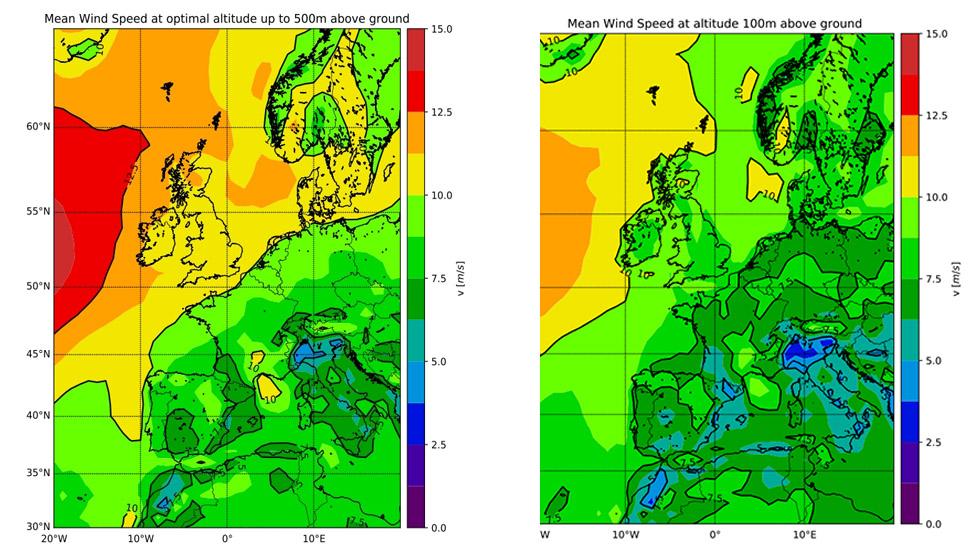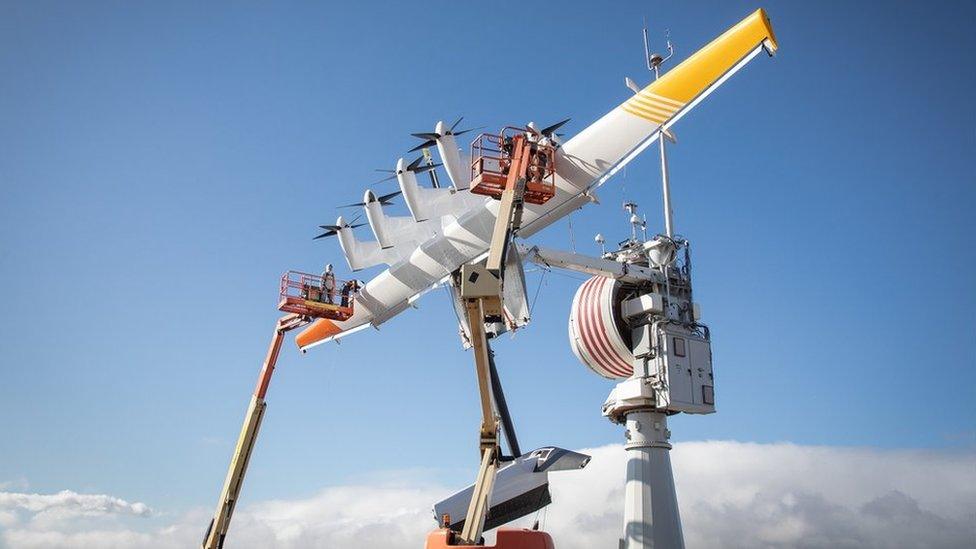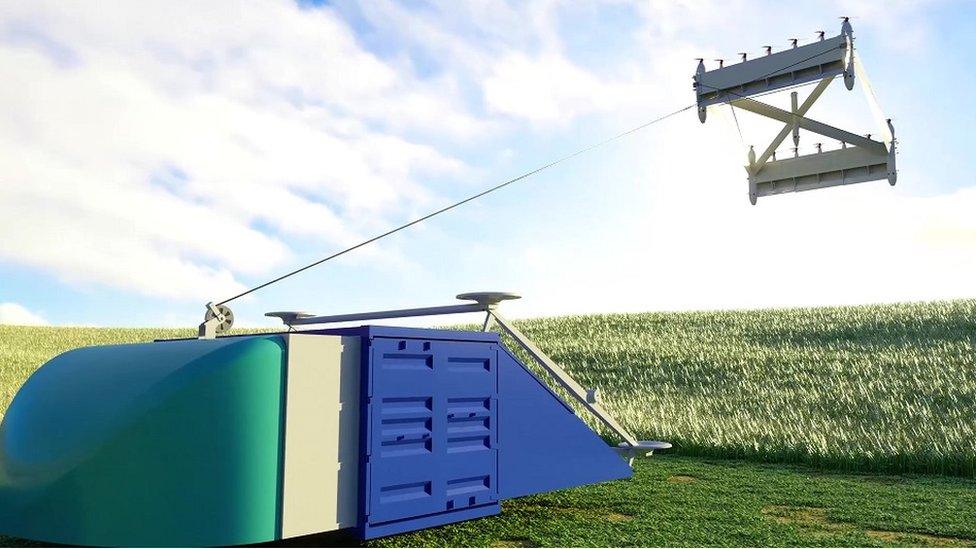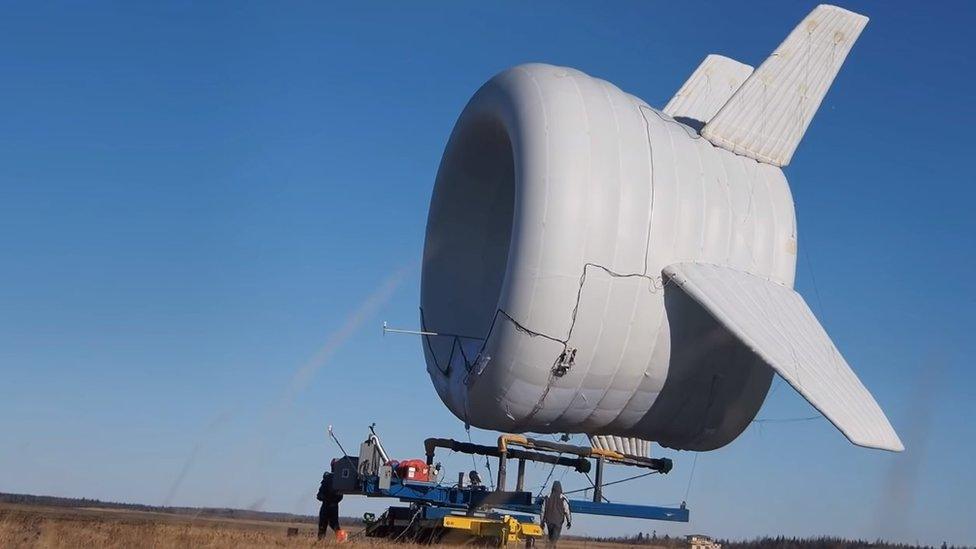Could high-flying drones power your home one day?
- Published
- comments

Makani's unmanned tethered drone soars high while its propellers generate electricity
A growing number of companies believe using tethered kites and drones is a viable way to harness the stronger and more consistent high-altitude winds. Could this tech release wind power's full potential, or will it always remain a niche solution?
Wind power generated five times more electricity in 2018 than in 2008, according to recent figures from the US Energy Information Administration.
Yet it still only accounts for about 4% of the world's electricity.
Critics point to the fact that the wind doesn't always blow - the intermittency problem - making this form of renewable energy unreliable.
But winds at higher altitudes - above 500m (1,640ft) - blow stronger and more consistently. An influential 2012 study from California's Lawrence Livermore National Laboratory found that high-altitude winds alone could provide 100 times the global energy need.

These charts show how average wind speeds increase at higher altitudes
"Wind turbines have been getting bigger and bigger in a bid to access winds at high altitude," says Udo Zillmann of trade association Airborne Wind Europe. "But that means huge, expensive towers."
So hi-tech drones and kites are now becoming accepted, lower-cost supplements, he argues.
"Airborne wind energy is a minimalistic version of a turbine, incorporating only the necessary elements: a blade and a tether measuring a few centimetres in diameter," he explains.

Makani readies its kite before a test flight in Hawaii
"These systems require between 1% and 10% of the materials used to construct a turbine and can also be grounded if required, for example to ease the passage of migrating birds."
Makani, part of Google's parent company Alphabet, is one of the companies working in the high-altitude wind space.
Its huge prototype kite is tethered to the ground and guided in loops by flight computers that use GPS and other sensors.
As the kite completes its loops, rotors on the 26m (85ft) wing spin in the wind, powering generators to produce electricity down the tether to the grid.
Makani began testing its current prototype, which is designed to produce up to 600 kilowatts of electricity - enough to power about 300 homes - in 2015.

Udo Zillmann thinks wind drones will be a crucial part of our renewable energy future
And in partnership with energy giant Shell, it is about to trial a new offshore system mounted on floating buoys.
"We plan to mount Makani's kite on a small spar buoy moored with a synthetic line and gravity anchor," says the firm's chief executive, Fort Felker.
"This is possible because Makani's kites are 90% lighter than turbines of a similar power rating. It's an exciting technical challenge."
Flying energy-capturing kites or drones offshore makes sense from a regulatory point of view, given that some can travel 600m in each direction.
"You need a huge area to operate even one device, which is one reason many companies are looking offshore," says Mr Zillmann.
There are also a number of companies working on ways to use wind power-generating drones over land, though.
Swiss start-up Skypull, for example, has developed an autonomous drone that can fly as high as 600m - about three times the height of a traditional wind turbine.
Its current prototype is a rigid wing, multi-copter "box-wing" drone that can take off and land by itself, with no need for a launcher or ground wind.

Skypull's "box-wing" drone takes flight on its winch
The take-off is battery powered, but once in the air the battery is recharged every time the kite loops back down towards the ground.
"Once it has climbed to operating height, the drone transitions to kite mode by turning 90 degrees from the upright position, and generates traction on the tether, which is attached to a winch that is linked to a generator," explains Skypull chief executive Nicola Mona.
"It's a system that enables us to fly between 200m and 600m above the ground in any location."
Early usage is likely to be limited to smaller projects, Mr Mona admits, but he believes the Skypull system could one day be used to meet large-scale energy demands.


"In the mid-term, I can see our technology being used for remote off-grid systems, such as mining operations and disaster relief projects," he says.
"In the longer term, however, I foresee larger wind farms capable of generating up to 100MW [megawatts] of power."
Other onshore high-altitude wind players include Altaeros Energies, a Massachusetts-based technology company that attracted investment from Mitsubishi Heavy Industries in 2015.
Its Buoyant Airborne Turbine involves a helium-filled shell that lifts a wind turbine to 600m above ground, and aims to supply power, telecommunication, and other services to the billions of people around the world who live without reliable electricity and internet access.

Altaeros' Buoyant Airborne Turbine generates electricity and provides internet connectivity
The big drawback of such systems is that they don't generate that much electricity compared to current turbines. Makani's huge propellered drone, for example, produces about 20 times less electricity than the largest offshore turbines currently being developed. These can produce up to 12MW (megawatts).
So you would need hundreds of them to produce enough electricity to power a small city, for example.
This is why Mr Zillmann sees them more as "the next step in the digitalisation of the traditional windmill", and expects them to be used in parallel with traditional wind turbine towers "for a long time yet".
But renewable energy - wind, solar, hydro - is "definitely capable of meeting the entire world's energy needs, and drones can help us achieve this", he concludes.
Follow Technology of Business editor Matthew Wall on Twitter, external and Facebook, external